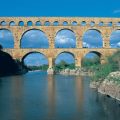Listed as a Unesco World Heritage Site, this architectural gem is accessible to all and delights young and old alike.
Listed as a Unesco World Heritage Site as a "testimony to human creative genius", the Pont du Gard was also awarded the "Grand Site de France" label in 2004, as well as the "Qualité Sud de France" and "Qualité Tourisme" labels. All of which are no mean feats for this limestone colossus, a veritable architectural gem and one of the finest examples of Roman engineering in France today. The Pont du Gard breaks several records: it is the highest Roman bridge still intact today, but also one of the best preserved, and the only one to have retained all three levels. Its weight is estimated at around 50,000 tonnes... 50,000 tonnes of limestone that the Romans transported and skilfully stacked almost 2,000 years ago, using techniques that still retain an element of mystery.
Built around the year 50, the aqueduct is without doubt the most audacious work of the Roman Empire known to date. The 52-arched stone giant that spans the wild Gardon gorge actually represents only 10% of the structure built by the Romans. The Pont du Gard is in fact the monumental part of an aqueduct more than 52 km long, which brought water from the Fontaine d'Eure, at the foot of Uzès, to the Roman city of Nemausus, now Nîmes, then at its height.
For almost 5 centuries, the aqueduct carried water between the two banks and supplied the city of Nîmes with drinking water, before being abandoned in the early 6th century. In the Middle Ages, the piers on the second level were indented so that the structure could be used as a road bridge. In 1840, Prosper Mérimée had the Pont du Gard included on France's first list of historic monuments, and launched the first major restoration work. It was classified as a Monument Historique by the 1840 list, and was included on the Unesco World Heritage list in December 1985.
Today, this monument is the most visited site in Occitanie, and rightly so, as seeing it again and again is always moving. Inscribed on Unesco's World Heritage List in 1985, no visitor facilities existed until the 2000s. These are now relevant, and the site has become very accessible for families. The bridge is illuminated every evening, and a colorful projection show takes place free of charge at dusk in summer. To get the full measure of the masterpiece that stands before you, you can take part in a one-hour guided tour.
Did you know? This review was written by our professional authors.
Members' reviews on PONT DU GARD
The ratings and reviews below reflect the subjective opinions of members and not the opinion of The Little Witty.
Le pont du Gard est le pont du Gard, notre monde contemporain lui a juste ajouté des aménagements, pas toujours du meilleur goût, notamment sur les côtés des rives, dénaturant à mon goût le site qui aurait conservé son authenticité avec le caractère sauvage des alentours avec un minimum d'infrastructures. Ici, lorsque vous arrivez sur le site en voiture vous êtes tout de suite dirigés vers le parking et, SANS QU'AUCUNE INDICATION TARIFAIRE VISIBLE soit présente la borne à l'entrée vous demande un octroi de 18 euros (forfait 2 personnes et sans pouvoir faire demi tour les jours d'affluence) et plus si vous êtes davantage et encore 4 euros s'il vous prend de traverser le pont sur la partie intérieure supérieur, après avoir fait la queue aux caisses. Cher la journée en famille, un petit air de racket...
Par contre les sentiers de randonnées ne sont pas tous bien balisés, ce qui est dommage.
Prix prohibitif pour entrer sur le site: 18 euros pour la voiture et ses passagers.
>> Gratuit pour les habitants du Gard












Possibilité de visiter le sommet moyennant un supplément payable sur place.